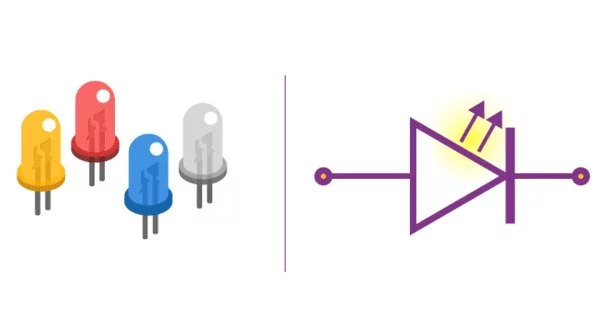A light-emitting diode (LED) is a semiconductor device that emits light when current flows through it. Electrons in the semiconductor recombine with electron holes, releasing energy in the form of photons. The energy required for electrons to cross the band gap of the semiconductor determines the color of the light (corresponding to the energy of photons). Multiple semiconductors or a layer of light-emitting phosphor on the semiconductor device are used to produce white light.
LEDs are constructed from a specially designed semiconductor material, which is typically gallium arsenide (GaAs) or gallium phosphide (GaP). The material is doped with impurities to produce an n-type region with an excess of electrons and a p-type region with a deficiency of electrons (known as “holes”). Electrons and holes are injected into the junction between the two regions when a voltage is applied across the LED.
The first LEDs, which appeared as practical electronic components in 1962, emitted low-intensity infrared (IR) light. Infrared LEDs are used in remote-control circuits found in a wide range of consumer electronics. The first visible-light LEDs were low-intensity and only available in red. Early LEDs were commonly used as indicator lamps to replace small incandescent bulbs, as well as in seven-segment displays.
At the junction, electron-hole recombination occurs, resulting in the release of energy in the form of photons. The photons’ energy determines the color of light emitted by the LED. LEDs emit various colors, including red, green, blue, and combinations of these colors, due to the use of various semiconductor materials and doping agents.
Later developments resulted in LEDs with visible, ultraviolet (UV), and infrared wavelengths, as well as high, low, or intermediate light output, such as white LEDs for room and outdoor area lighting. LEDs have also given rise to new types of displays and sensors, and their fast switching rates are useful in advanced communications technology with applications ranging from aviation lighting to fairy lights, automotive headlamps, advertising, general lighting, traffic signals, camera flashes, lighted wallpaper, horticultural grow lights, and medical devices.
Advantages
LED lighting has several advantages over incandescent and fluorescent lighting technologies. They are extremely energy-efficient, converting a large portion of electrical energy into light rather than heat. As a result of this efficiency, energy consumption and electricity costs are reduced. LEDs have a long operational life as well, often lasting tens of thousands of hours before needing to be replaced.
Application
LEDs are widely used in a wide range of applications, including residential and commercial lighting, automotive lighting, display and television backlighting, indicator lights, and even large-scale outdoor displays and signage. They’ve also become popular in horticulture for indoor plant growth due to their ability to emit specific wavelengths of light that promote photosynthesis.
LED technology has advanced in recent years, resulting in the development of high-brightness LEDs capable of producing intense illumination for general lighting purposes. Furthermore, advances in color-mixing techniques and control systems have made it possible to create full-color LED displays and sophisticated lighting effects.















